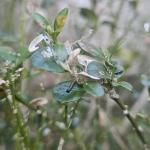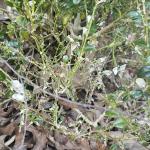UMass Extension's Landscape Message is an educational newsletter intended to inform and guide Massachusetts land care professionals in the management of our collective landscape. Detailed reports from scouts and Extension specialists on growing conditions, pest activity, and cultural practices for the management of woody ornamentals, trees, and turf are regular features. The following issue has been updated to provide timely management information and the latest regional news and environmental data.
Welcome to Landscape Message #3 for the 2024 growing season. The next message will be published in two weeks, on May 3. To receive immediate notification when the next Landscape Message update is posted, be sure to join our e-mail list
Click on the headings below to jump to that section of the message.
In This Issue
Scouting Information by Region
Woody Ornamentals
Scouting Information by Region
Environmental Data
The following data was collected on or about April 17, 2024. Total accumulated growing degree days (GDD) represent the heating units above a 50ºF baseline temperature collected via regional NEWA stations (http://newa.cornell.edu) for the 2024 calendar year. This information is intended for use as a guide for monitoring the developmental stages of pests in your location and planning management strategies accordingly.
|
MA Region/Location |
2024 Growing Degree Days |
Soil Temp |
Precipitation |
Time/Date of Readings |
||
| Gain since last report |
2024 total |
Sun |
Shade |
|||
|
CAPE |
18 |
19 |
53 |
49 |
2.52 |
12:00 PM 4/17/2024 |
|
SOUTHEAST |
29 |
35 |
65 |
50 |
1.75 |
3:00 PM 4/17/2024 |
|
NORTH SHORE |
11 |
11 |
53 |
45 |
2.13 |
12:00 PM 4/17/2024 |
|
EAST |
24 |
26 |
55 |
48 |
2.72 |
4:00 PM 4/17/2024 |
|
METRO |
20 |
22 |
48 |
45 |
2.41 |
6:30 AM 4/17/2024 |
|
CENTRAL |
25 |
26 |
45 |
44 |
3.98 |
1:00 PM 4/18/2024 |
|
PIONEER VALLEY |
23 |
26 |
49 |
49 |
4.10 |
1:30 PM 4/17 /2024 |
|
BERKSHIRES |
13 |
13 |
43 |
43 |
3.56 |
8:00 AM 4/17 2024 |
|
AVERAGE |
20 |
22 |
51 |
47 |
2.90 |
- |
|
n/a = information not available |
||||||
US Drought Monitor: Once again, no significant changes from our report two weeks ago... in Massachusetts, only Nantucket island has an official drought designation at this time, classified as D0 (Abnormally Dry). State map as of Thursday 4/18: https://droughtmonitor.unl.edu/CurrentMap/StateDroughtMonitor.aspx?MA
Phenology
| Indicator Plants - Stages of Flowering (BEGIN, BEGIN/FULL, FULL, FULL/END, END) | ||||||||
|---|---|---|---|---|---|---|---|---|
| PLANT NAME (Botanic / Common) | CAPE | S.E. | N.S. | EAST | METRO W. | CENT. | P.V. | BERK. |
|
Cercis canadensis (redbud) |
* |
* |
* |
* |
Begin |
* |
Begin |
* |
|
Amelanchier spp. (shadbush, serviceberry) |
* |
Begin |
Begin |
* |
Begin |
Begin |
Begin |
* |
|
Pyrus calleryana (Callery pear) |
Begin |
Begin |
Begin |
Begin |
Begin |
Begin |
Full |
* |
|
Magnolia soulangiana (saucer magnolia) |
Begin |
Full |
Full |
Begin/Full |
Begin |
Begin |
Full |
Begin |
|
Prunus serrulata (Japanese flowering cherry) |
* |
* |
Full |
Full |
Full |
Full |
Begin/Full |
Begin |
|
Magnolia stellata(star Magnolia) |
Begin/Full |
Full |
Full |
Full/End |
Begin/Full |
Full |
Full |
Begin/Full |
|
Forsythia x intermedia (border Forsythia) |
Full |
Full |
Full |
Full |
Full |
Full |
Full |
Full |
|
Pieris japonica (Japanese Pieris) |
End |
Full |
Full |
Full |
Full |
Full |
Full |
Full |
|
Cornus mas (Cornelian cherry dogwood) |
Full/End |
End |
End |
End |
End |
Full/End |
End |
Full/End |
|
Acer rubrum (red maple) |
Full/End |
* |
End |
End |
End |
Full/End |
End |
End |
| * = no activity to report/information not available | ||||||||
Regional Notes
Cape Cod Region (Barnstable)
General Conditions:
The average temperature from April 3 thru April 17 was 47°F with a high of 68°F on April 15 and a low of 31°F on April 5. The period started cold, wet, and cloudy with temperatures staying in the 30s and 40s from April 3-8. Temperatures warmed on the 9th, with highs primarily in the 50s and lows in the 40s, and the reporting period ended with a couple of days in the 60s. The period had a near equal number of cloudy and sunny days. Approximately 2.5 inches of precipitation was received from several precipitation events, with the majority coming on April 3, 4 and 12. Soil moisture is adequate.
Herbaceous plants seen in bloom during the period include hellebore (Helleborus orientalis), daffodils (Narcissus spp.), hyacinths (Hyacinthus spp.), grape hyacinth (Muscari armeniacum), lungwort (Pulmonaria officinalis) and barrenwort (Epimedium spp.). Woody plants seen in bloom include willows (Salix spp.), flowering quince (Chaenomeles speciosa) and Rhododendron ‘PJM’.
Pests/Problems:
Box tree moth was discovered in several towns of the upper Cape last season. This insect is capable of defoliating boxwood if left unmanaged. Box tree moth is active and should be scouted for.
Winter moth hatch is imminent, if not already underway; however, in a quick search of maple and blueberry buds on the upper Cape, no larvae were found. Winter moth no longer requires management in ornamental settings; however, it may be necessary for fruiting apples and blueberries.
Insects or insect damage seen during the period include black turpentine beetle damage to pitch pine and boxwood leafminer damage on boxwood. Bud blast has been observed on some rhododendrons. Bud blast results in damaged flower buds that are often brown, desiccated and come off easily.
Invasive fig buttercup (Ficaria verna) is in bloom as well as the weeds hairy bittercress (Cardamine hirsuta), chickweed (Stellaria media), mouse-ear cress (Arabidopsis thaliana), henbit (Lamium spp.), speedwell (Veronica spp.), and common groundsel (Senecio vulgaris).
Southeast Region (Dighton)
General Conditions:
With the arrival of warm sunny days, lawns have greened up nicely. Many have had their first cut. Green buds, new leaves and flowers are everywhere in the landscape. The high temperature over the past two weeks was 76°F on the afternoon of April 15th. The low was 32°F on the morning of April 5th. The average temperature was 48°F. The highest sustained winds were 22 mph from the NE on April 4th. The same nor’easter gave us heavy rains Wednesday, April 3rd, through Thursday, the 4th. Otherwise, showers were light and passing on April 6th, 12th, 13th, and 14th. The total rainfall was 1.75 inches. The soil temperature in full sun was 65°F, and in shade 50°F as of Wednesday afternoon, 3 PM, April 17th.
Plants in flower include swamp red maple (Acer rubrum), shadblow (Amelanchier canadensis), common flowering quince (Chaenomeles speciosa), border forsythia (Forsythia x intermedia), saucer magnolia (Magnolia x soulangiana), star magnolia (M. stellata), Japanese andromeda (Pieris japonica), Callery pear (Pyrus calleryana), Rhododendron P. J. M., and Korean all-spice viburnum (Viburnum carlisii). Cornelian cherry (Cornus mas) has ended flowering.
Pests/Problems:
Dandelions are flowering. There's nothing that says Spring like having clients call about a few dandelions flowering on otherwise weed-free verdant green lawns.
Ticks are questing for hosts.
North Shore (Beverly)
General Conditions:
Temperatures during the first week of this two-week reporting period were below average for this time of the year. This changed in the last few days with temperatures getting much higher than average. The weather pattern was variable, fluctuating from overcast and rainy days to clear sky and sunny days. The average daily temperature in the last two weeks was 45oF with a minimum of 31oF recorded on April 8 and maximum of 69oF recorded on April 15. The last snowfall for the season occurred on April 4th with a total accumulation of 1.3 inches. Approximately 2.13 inches of precipitation were received at Long Hill during this period, with most of it occurring on Thursday, April 4.
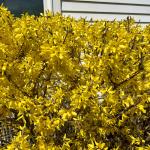 Soil is moist and grass on lawns is greening up and many landscape plants are starting to bloom. There is a lot of yellow color in the landscape from different forsythias in bloom including: border forsythia (Forsythia intermedia), weeping forsythia (Forsythia suspensa), and Giraldi forsythia (Forsythia giraldiana). Other woody plants seen in bloom include: Merrill magnolia (Magnolia x loebneri ‘Merrill’), Japanese pieris (Pieris japonica), weeping higan cherry (Prunus subhirtella), star magnolia (Magnolia stellata), cylindrical magnolia (Magnolia cylindrica), Sargent cherry (Prunus sargentii), and mountain pieris (Pieris floribunda). Spring flowering herbaceous plants in full bloom include: daffodils (Narcissus spp.), bloodroot (Sanguinaria canadensis), hellebores (Helleborus orientalis), and vinca (Vinca minor).
Soil is moist and grass on lawns is greening up and many landscape plants are starting to bloom. There is a lot of yellow color in the landscape from different forsythias in bloom including: border forsythia (Forsythia intermedia), weeping forsythia (Forsythia suspensa), and Giraldi forsythia (Forsythia giraldiana). Other woody plants seen in bloom include: Merrill magnolia (Magnolia x loebneri ‘Merrill’), Japanese pieris (Pieris japonica), weeping higan cherry (Prunus subhirtella), star magnolia (Magnolia stellata), cylindrical magnolia (Magnolia cylindrica), Sargent cherry (Prunus sargentii), and mountain pieris (Pieris floribunda). Spring flowering herbaceous plants in full bloom include: daffodils (Narcissus spp.), bloodroot (Sanguinaria canadensis), hellebores (Helleborus orientalis), and vinca (Vinca minor).
Pests/Problems:
Needle cast disease was observed on some spruce trees in the landscape. Annual weed seeds continue to germinate. Yellow buttercup weed (Ranunculus ficaria) has started to form masses of green carpets with yellow flowers. No major pest activity was observed but ticks are now active due to the increase in temperature. It is important to protect yourself when working outdoors with a repellent such as DEET.
East (Boston)
General Conditions:
April began cool and wet. We received 1.28 inches of precipitation on April 4th with a chilly daytime high temperature of 37oF. Hopefully our last threat of a frost was an overnight low of 32oF on April 8th. A nor’easter came through on the 12th; bringing high winds, 0.73 inches of rain and a welcome change in general conditions. From April 12th to the 16th, daytime temperatures have averaged 64oF with sunny skies. We reached a high of 73oF on the 15th, the first day in the 70’s since October. Overnight lows have averaged 45oF. We have accumulated 2.77 inches of precipitation thus far in April. Some plants in bloom include; Lindera benzoin (spice bush), Magnolia x soulangeana (saucer magnolia), Myosotis sylvestris (woodland forget-me-not), Prunus ‘Karl Sax’ (Karl Sax flowering cherry), Prunus ‘Okame’ (Okame flowering cherry), and Prunus subhirtella (Higan cherry).
Pests/Problems:
Taraxacum officinale (dandelion) is flowering in turfgrass. Green masses of Ficaria verna (lesser celandine), covered with small yellow flowers, are colonizing moist locations. Alliaria petiolata (garlic mustard) seedlings are carpeting disturbed areas. The new red foliage of Polygonum cuspidatum (Japanese knotweed) has emerged.
Metro West (Acton)
General Conditions:
Much has happened outside and within the past two weeks since the last report. Lawns are greening up and leaf and flower buds are expanding and opening. We experienced some winter-like weather during this reporting period with a nor’easter on April 4th that resulted in a light blanket of snow covering the landscape and school delays and cancellations. Outside temperatures continue to fluctuate, a high of 72oF was recorded on the 15th, and evening temperatures continue to fall near freezing. Frost was found on my car windshield on the morning of the 8th. Some form of precipitation has been recorded for this area on ten of the sixteen days this month, bringing our total rainfall recorded for this April to 2.44”. We need just 2 more inches of rain to meet our average rainfall for the month of April, which is 4.43”.
Pests/Problems:
Soils are well saturated; rivers, lakes, and pond water levels are high; low-lying areas are flooded; and erosion from rain, downed branches and twigs from strong wind gusts, rodent damage to lawns and plants are some of the things that I have observed out in the landscape. Acer platanoides (Norway maple) is in full bloom. This invasive tree is hard to miss now that it is in bloom; its flowers are a bright yellowish-green and are easily seen on a tree found growing most everywhere. Another problem plant seen flourishing is the basal foliage of Alliaria petiolata (garlic mustard). Other weeds seen in bloom but without the invasive tendency of the previous two mentioned are: Draba verna (spring whitlow grass), Glechoma hederacea (ground ivy), Lamium purpureum (purple deadnettle), Stellaria media (common chickweed), and Taraxacum officinale (dandelion). Black flies are out.
Central Region (Boylston)
General conditions:
Warmer weather with rain (some snow of course) and multitudes of emerging flowers and leaves have been the theme since the last report. Cold mornings that soon warm up help to open those flowers, with the maximum temperature hitting 73.2oF on the 9th. However, we also received a bit of a snowstorm on the 4th, which didn’t seem to cause too much damage to the already blooming plants. A lot of rain has encouraged growth, though winds seemed to have affected a lot of surrounding trees including red maple (Acer rubrum) and their clumps of red flowers scattered everywhere. A variety of blooms can be seen in the region which almost seemed to just pop open within this past week. For trees/shrubs/woody material: star magnolia (Magnolia stellata) and hybrids, saucer magnolia (Magnolia x soulangeana), flowering cherries (Prunus spp.), Cornell pink azalea (Rhododendron mucronulatum), and PJM rhododendron (Rhododendron spp. 'PJM'). For herbaceous plants: all spring ephemerals are having quite a show, including all daffodils (Narcissus spp.), tulips (Tulipa spp. ), hellebores (Helleborus spp.), bloodroot (Sanguinaria canadensis), wood poppy (Stylophorum diphyllum), trout lily (Erythronium americanum), and even the feathery flowers of Alleghany spurge (Pachysandra procumbens).
Pests/Problems:
Along with intentional flowering plants, unintentional plants such as dandelions are trying to have their place this spring which creates plenty of weeding time. Another presence that has emerged along with this warmer weather is ticks, both deer and dog ticks. Lastly, a common problem across different regions that we share is the large amount of wind and gusty days we’ve had. Many downed trees and branches litter the landscape, unfortunately harming weaker woody plant material.
Pioneer Valley (Amherst)
General Conditions:
If “April showers bring May flowers”, then we’re in for a profusion of blooms next month. Cloudy and wet conditions dominated this past reporting period, intermixed with a handful of days boasting bright sun and clear skies. A late season nor’easter swept through the region on 4/4, depositing 2” of snow, sleet and rain across the valley bottom. April snow is seldom welcomed and it lingered for several days in shaded landscapes. Clear skies developed for the eclipse on 4/8 and this celestial phenomenon did not disappoint. The day of the eclipse was one of only five mostly sunny days this month (4/8–9 & 4/15–17). An extended period of clouds and showers from 4/10 through 4/14 peaked with heavy rain and thunderstorms on the morning of 4/12. Accumulations ranged from 1–3” across the tri-counties with the highest totals in western Hampshire and Franklin counties. Since March 1, precipitation totals have ranged from 10–15”, illustrating just how wet this spring season has been. The Connecticut River has been swollen all month and there’s been localized flooding from the Mill River in Hampshire County. The mild temperatures coupled with the increasingly warming soils has accelerated plant development across the landscape. Forsythia, PJM rhododendrons, flowering cherries, and early azaleas all have excellent color right now. Cherries in particular look great, in contrast to last year at this time when the early February deep freeze destroyed most of their flower buds. Turfgrasses have rapidly greened and the first mowing has commenced on scattered lawns. Pollen season is quickly ramping up with more plants pushing growth combined with the windy conditions of the season. Spring peepers have been very active and this evening chorus is one of the great sounds of spring.
Pests/Problems:
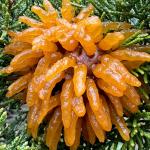 The persistent cloudy and wet weather combined with the mild temperatures and high humidity overnight on 4/11 and 4/12 created ideal conditions for Gymnosporangium rust fungi. They can be found sporulating on Juniperus, especially eastern redcedar (J. virginiana). Diseases caused by Gymnosporangium include cedar-apple rust (pictured here), cedar-quince rust, hawthorn rust, and pear trellis rust, among many others. Aphids on newly emerging Japanese maple leaves were observed. These sucking insects don’t cause major damage, but heavy infestations can deform leaves as they develop in the spring. For smaller trees, a strong jet of water from a spray bottle can dislodge them. Additional early season aphid pests such as snowball aphids on viburnum and balsam twig aphids on balsam/Fraser fir will be visible soon as new growth develops. Deer browse on tulips was also observed. The tearing action of their feeding pulled several bulbs right out of the soil. This time of year, a variety of small green caterpillars can chew and roll leaves of deciduous hardwoods. Careful scouting is required to find them and for recently transplanted trees, they should be removed.
The persistent cloudy and wet weather combined with the mild temperatures and high humidity overnight on 4/11 and 4/12 created ideal conditions for Gymnosporangium rust fungi. They can be found sporulating on Juniperus, especially eastern redcedar (J. virginiana). Diseases caused by Gymnosporangium include cedar-apple rust (pictured here), cedar-quince rust, hawthorn rust, and pear trellis rust, among many others. Aphids on newly emerging Japanese maple leaves were observed. These sucking insects don’t cause major damage, but heavy infestations can deform leaves as they develop in the spring. For smaller trees, a strong jet of water from a spray bottle can dislodge them. Additional early season aphid pests such as snowball aphids on viburnum and balsam twig aphids on balsam/Fraser fir will be visible soon as new growth develops. Deer browse on tulips was also observed. The tearing action of their feeding pulled several bulbs right out of the soil. This time of year, a variety of small green caterpillars can chew and roll leaves of deciduous hardwoods. Careful scouting is required to find them and for recently transplanted trees, they should be removed.
Berkshire Region (West Stockbridge)
General Conditions:
The recent scouting period began with cold temperatures as well as rain, sleet, and some heavy wet snow throughout Berkshire County on April 3, 4 and 5. High winds were also a factor, especially on April 3. However, the lowest morning temperatures occurred on April 8 with 26oF in Pittsfield and Richmond, and 27oF in North Adams. Interestingly, the weather quickly warmed up. In fact, the highest temperature for the period occurred the following day, i.e. April 9. The high temperatures on that day were 73oF in North Adams, 71oF in Pittsfield, and 70oF in Richmond. It was also a wet time with rain occurring on 7 of the 14 days, the longest stretch being from April 10–14. As such, soils were drenched and are still quite moist. The combination of warming temperatures and plenty of soil moisture has prompted the growth of grass and mowing has started. It is a colorful time due to the emergence of flowers on many bulb plants and several flowering trees and shrubs. Vinca minor (periwinkle), one of the earliest blooming groundcovers, is putting on its spring show.
Pests/Problems:
Perhaps the most serious problem of the past two weeks was the wind, with reported gusts as high as 60 mph in some areas. This, of course, resulted in many downed limbs and trees, as well as power outages. The heavy rains caused considerable soil erosion in gardens on or at the bottom of slopes. Pest problems remain few now. With all the moisture, slugs are active and have been feeding on the foliage of emerging herbaceous perennials. The deer tick (Ixodes scapularis) population remains high and ticks are frequently found on humans as well as pets allowed to roam outdoors. Boxwood leaf miner (Monarthropalpus flavus) is currently in its yellow/orange larval stage and can be found in the yellow blisters on the leaves of boxwood. The warm weather has brought out mosquitoes. Voles and mice have been a problem throughout the winter and fed on woody plant stems as well as stems of mulched perennials. In one reported incident, the roots of mulched roses were completely devoured. The weather has not only encouraged ornamental plant growth but has also encouraged weed growth, e.g. lesser celandine (Ficaria verna) on lawns and garlic mustard (Alliaria petiolata) in wood lots.
Regional Scouting Credits
- CAPE COD REGION - Russell Norton, Horticulture and Agriculture Educator with Cape Cod Cooperative Extension, reporting from Barnstable.
- SOUTHEAST REGION - Brian McMahon, Arborist, reporting from the Dighton area.
- NORTH SHORE REGION - Geoffrey Njue, Green Industry Specialist, UMass Extension, reporting from the Long Hill Reservation, Beverly.
- EAST REGION - Kit Ganshaw & Sue Pfeiffer, Horticulturists reporting from the Boston area.
- METRO WEST REGION – Julie Coop, Forester, Massachusetts Department of Conservation & Recreation, reporting from Acton.
- CENTRAL REGION - Mark Richardson, Director of Horticulture, and Anna Petrie, reporting from New England Botanic Garden at Tower Hill, Boylston.
- PIONEER VALLEY REGION - Nick Brazee, Plant Pathologist, UMass Extension Plant Diagnostic Lab, reporting from Amherst.
- BERKSHIRE REGION - Ron Kujawski, Horticultural Consultant, reporting from Great Barrington.
Woody Ornamentals
Diseases
Recent pests, pathogens, or problems of interest seen in the UMass Extension Plant Diagnostic Lab, a select few:
New and/or Updated Disease Fact Sheets in 2024
- Cryptocline Needle Blight
- Exobasidium Gall of Rhododendron and Azalea
- Birch Anthracnose
- Venturia Leaf and Shoot Blight of Aspen
- Oak Leaf Blister
- Root and Trunk Rot caused by Ganoderma applanatum (Artist’s Conk)
- Brown Rot of Stone Fruits
- Pseudocercospora Leaf Spot of Mountain Laurel
- Cedar-Apple Rust
- Delphinella Shoot Blight
A new beech leaf disease study describes a quick method for diagnosis of the disease from infested buds: Wolf E. and Vieira P. 2024. Rapid assessment of beech leaf disease in Fagus sylvatica buds. Forest Pathology 54, e12858.
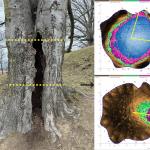 Root and butt rot on a mature European beech (Fagus sylvatica) caused by Armillaria. This large (61” dbh), multi-leader beech on the UMass campus has been declining for many years. The tree resides on Baker Hill, adjacent to a busy walkway, in full sun and exposed to strong winds. Despite the hillside location, the water table is high in this area, with standing water developing after heavy rains on the lawn just downslope. A large cavity on the southern side of the trunk clearly illustrates the damage caused by Armillaria. Recently, sonic tomograms were captured at two heights on the lower trunk to understand the severity of decay on the north side of the tree, opposite the cavity. Interestingly, the lower-level scan (lower right in image) indicated there is a significant amount of healthy wood around the cavity. Healthy wood appears brown in the sonic tomogram while damaged wood appears green, violet and blue. However, the sonic tomogram captured at the upper height, taken just beneath the union of the co-dominant leaders, indicated very extensive decay is present (upper right in image). There is significant branch dieback in the upper canopy and the fungal cankering pathogen Nectria has also been observed on the tree. For the past several years, there has also been a yellow jacket nest within the cavity.
Root and butt rot on a mature European beech (Fagus sylvatica) caused by Armillaria. This large (61” dbh), multi-leader beech on the UMass campus has been declining for many years. The tree resides on Baker Hill, adjacent to a busy walkway, in full sun and exposed to strong winds. Despite the hillside location, the water table is high in this area, with standing water developing after heavy rains on the lawn just downslope. A large cavity on the southern side of the trunk clearly illustrates the damage caused by Armillaria. Recently, sonic tomograms were captured at two heights on the lower trunk to understand the severity of decay on the north side of the tree, opposite the cavity. Interestingly, the lower-level scan (lower right in image) indicated there is a significant amount of healthy wood around the cavity. Healthy wood appears brown in the sonic tomogram while damaged wood appears green, violet and blue. However, the sonic tomogram captured at the upper height, taken just beneath the union of the co-dominant leaders, indicated very extensive decay is present (upper right in image). There is significant branch dieback in the upper canopy and the fungal cankering pathogen Nectria has also been observed on the tree. For the past several years, there has also been a yellow jacket nest within the cavity.
Phomopsis twig and branch cankering in the canopy of a mature Japanese maple (Acer palmatum ‘Bloodgood’). The tree is approximately 40 years old and has been present at the site nearly as long. It resides in part shade with well-drained, loam soils. During the summer of 2023, branch tip dieback in the upper canopy along with undersized foliage was observed. Drought stress during the summer of 2022 may have predisposed the tree to a cankering outbreak. There were no symptoms or signs of Verticillium wilt from the submitted branch segments and Phomopsis appears to be the primary cause of the dieback. When healthy, Japanese maples can resist cankering fungi like Phomopsis. However, when stressed, they become highly susceptible to cankering diseases.
Report by Nick Brazee, Plant Pathologist, UMass Extension Plant Diagnostic Lab, UMass Amherst
Insects and Other Arthropods
The Professional Insect and Mite Management Guide for Woody Plants is freely available at https://ag.umass.edu/insectmiteguide. Please let me know how it is or isn’t working for you here. Your feedback is valuable and I cannot wait to hear from you!
Invasive Updates:
- Asian Longhorned Beetle is still present in Worcester, Shrewsbury, Boylston, West Boylston, and parts of Holden and Auburn, MA. If you suspect you’ve found this insect or the damage it causes, please report it to the Asian Longhorned Beetle Eradication Program office in Worcester, MA at 508-852-8090 or toll free at 1-866-702-9938.
To report an Asian longhorned beetle find online or to compare it to common insect look-alikes, visit: http://massnrc.org/pests/albreport.aspx
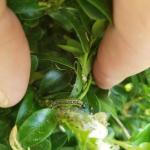 Box Tree Moth has been detected in the following Massachusetts communities: Bourne, Sandwich, and Barnstable. A map of these locations is available here. If you believe you have found this insect, please take a photo, note your location, and report it immediately here.
Box Tree Moth has been detected in the following Massachusetts communities: Bourne, Sandwich, and Barnstable. A map of these locations is available here. If you believe you have found this insect, please take a photo, note your location, and report it immediately here. Elm Zigzag Sawfly has been detected in the following Massachusetts communities: Becket, Chester, Windsor, and Williamstown. If you believe you have found this insect, please take a photo, note your location, and report it immediately here.
Elm Zigzag Sawfly has been detected in the following Massachusetts communities: Becket, Chester, Windsor, and Williamstown. If you believe you have found this insect, please take a photo, note your location, and report it immediately here.- Emerald Ash Borer is well established across most of Massachusetts. A map of these locations from the MA Department of Conservation and Recreation is available.
- Jumping Worms are non-native earthworms that impact natural ecosystems. Available resources include a fact sheet about earthworms in Massachusetts and jumping worm FAQ’s.
- Spotted Lanternfly now has established populations in the following locations in Massachusetts: Holyoke, Springfield, West Springfield, Agawam, Fitchburg, Worcester, Shrewsbury, Southborough, Ashland, Wellesley, Weston, and Chelmsford. If you believe you have found this insect, please take a photo, note your location, and report it immediately here. Available resources include a map of spotted lanternfly locations in Massachusetts from the MA Department of Agricultural Resources, MDAR’s spotted lanternfly fact sheet, UMass Extension’s Spotted Lanternfly Management Guide, and an SLF InsectXaminer episode.
Medically Important Pests:
- Ticks are a serious public health concern and may be active in managed landscapes any time temperatures are above freezing. Encounters with deer ticks can increase in New England in April, October, and November; however, precautions should be taken year-round to prevent tick bite exposure. Available resources include tick information from Cape Cod Cooperative Extension, personal protective measures, and a list of potential tick testing resources. The New England Center of Excellence in Vector-Borne Diseases (NEWVEC) also provides the latest tick information and resources.
- Mosquitoes and the diseases they vector are also a serious public health concern in Massachusetts by summer. Available resources include Mosquito Repellents from the Department of Public Health and Prevent Mosquito Bites from the Centers for Disease Control and Prevention. The Massachusetts Department of Public Health tests for Eastern Equine Encephalitis (EEE) and West Nile Virus (WNV) from June to October. Beginning in June, risk maps will be available here.
Tree & Shrub Insect & Mite Pest Suggested Scouting:
- Bagworm is overwintering on Juniperus spp., Thuja spp., Quercus spp., Platanus spp., and others as 500-1000 eggs can be found in the bags of last season’s deceased females. Now is the time to remove and destroy overwintering bags of eggs prior to egg hatch at approximately 600 GDD’s (approx. mid-June).
- Balsam Twig Aphid overwinters as eggs on host plant bark, trunks, and branches (primarily Abies and Picea spp.). Eggs hatch roughly between 30-120 GDD’s, approximately April-May. Nymphs quickly mature into stem mothers, which produce 20-40 young (each) without laying eggs. These young feed on buds and tender needles, and cause most of their feeding damage during that time. Scout now for curled or stunted needles from feeding in prior years.
- Black Turpentine Beetle overwinters as an adult in the bark of its host plants. Adults may become active as temperatures rise, typically by mid-April to mid-May. Attacked host trees may ooze 1.6 inch diameter red or white masses of pitch from the lower 6 feet of the trunk. Pitch pine, eastern white pine, and other species of pine or spruce may be hosts for this insect. Frequently an issue on stressed trees in eastern Massachusetts. Favored by drought or flooding conditions.
- Boxwood Leafminer is overwintering as a partially developed larva within Buxus spp. leaves. Larvae will become active as temperatures warm, with pupae present by late April. Adult emergence occurs by mid-May, with pupal cases left behind clinging to leaves. Shake bushes in late April to detect flying adults. Resistant varieties of boxwood are available; see preceding link.
- Boxwood Mite feeds on upper and lower leaf surfaces of Buxus spp. hosts. Overwintered eggs hatch into larvae in the spring, which mature into nymphs and eventually adults. The entire life cycle takes approximately 18-21 days. Most feeding injury occurs in the spring and hosts may appear off-color.
- Boxwood Psyllid nymphs have overwintered within eggshells inserted between bud scales last summer. As soon as buds expand, nymphs will emerge and begin feeding on Buxus spp. developing buds and leaves. Upward cupping and yellowing of leaves can be a sign of previous or current season’s damage. Dormant season horticultural oil applications may be made in the spring, as temperatures and weather conditions allow.
- Cankerworms can be found feeding on similar host plants in the spring, despite fall and spring cankerworm being different species of insects. Spring cankerworm adult moths are active in February and March, laying masses of 100 or so eggs in the rough bark of larger branches or the trunk of the host plant. Fall cankerworm adults laid their masses of eggs on host plant branches and twigs, back in late November and early December of last year (sometimes the current year’s January). Egg hatch of both species will occur by approximately mid-May, with caterpillar feeding through roughly the end of June.
- Cooley Spruce Gall Adelgid typically overwinters as an immature female near spruce twig terminals. By early spring, this female matures into a stem mother which will lay hundreds of eggs on lateral terminals. Following egg hatch, nymphal feeding induces gall formation on spruce hosts. Green galls on spruce may be removed and destroyed. On Douglas fir, the Cooley spruce gall adelgid’s alternate host, look for woolly masses in the spring and distorted or crooked needles. Do not plant spruce and Douglas fir close together when possible.
- Dogwood Sawfly overwinters as a larva in an overwintering “cell” created in soft, decaying wood material. Pupation occurs in the spring, and adults may emerge by late May through July. Eggs are laid in the underside of the host plant leaf, in groups of 100 or more.
- Eastern Spruce Gall Adelgid overwinters as a partially grown female, maturing into a stem mother by early spring. Stem mothers lay 100-200 eggs by budbreak. Eggs hatch and nymphs feed on the needles of their Picea spp. hosts. As green galls develop, prune out and destroy when possible.
- Eastern Tent Caterpillar overwintering eggs hatch in the spring and caterpillars emerge as cherry leaves begin to open. Look for groups of caterpillars feeding in silken tents at that time.
- Elm Leaf Beetle overwinters as an adult in protected areas, such as the loose bark of trees. Sometimes, they enter homes in search of a safe winter haven, and become a nuisance. As host plant leaves emerge, beetles fly back to chew small, semi-circular holes in the leaves. Eggs are laid in clusters on leaves and resemble pointy footballs. Each female can lay 600-800 eggs.
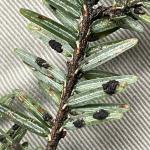
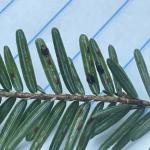 Elongate Hemlock Scale is primarily a pest of hemlock and fir. Overwintered fertilized females or their eggs will become active with warming temperatures, with egg hatch generally occurring by the end of May or the beginning of June. At that time, crawlers will be present before they settle to feed on a needle. Colletotrichum fioriniae was observed on elongate hemlock scales in Lynnfield, MA on 2/23/2024 and again in Manchester, MA on 3/19/2024 by Richard Grant (see photos). C. fioriniae is an endophytic fungus that lives within the needles of hemlock. Up to 90% mortality can occur in elongate hemlock scale if this fungus invades the insect. Scales appear coated in a black material, looking similar to sooty mold (it is not sooty mold). This fungus was reported as active in elongate hemlock scale populations in western MA in 2023 as well.
Elongate Hemlock Scale is primarily a pest of hemlock and fir. Overwintered fertilized females or their eggs will become active with warming temperatures, with egg hatch generally occurring by the end of May or the beginning of June. At that time, crawlers will be present before they settle to feed on a needle. Colletotrichum fioriniae was observed on elongate hemlock scales in Lynnfield, MA on 2/23/2024 and again in Manchester, MA on 3/19/2024 by Richard Grant (see photos). C. fioriniae is an endophytic fungus that lives within the needles of hemlock. Up to 90% mortality can occur in elongate hemlock scale if this fungus invades the insect. Scales appear coated in a black material, looking similar to sooty mold (it is not sooty mold). This fungus was reported as active in elongate hemlock scale populations in western MA in 2023 as well.- Euonymus Caterpillar tiny, overwintered larvae have spent their time beneath eggshells from last year. As temperatures increase in the spring, groups of caterpillars will begin feeding on newly emerging Euonymus spp. leaves. Additional resources include an InsectXaminer episode about euonymus caterpillar.
- Euonymus Scale overwinters as a fertilized female. Eggs are laid beneath dark brown female scale covers in the early spring. Egg hatch occurs over a 2-3 week period, with crawlers present by early June. While Euonymus spp. host plants are preferred, additional host plants have been reported.
- European Pine Sawfly eggs have overwintered in slits in last year’s needles. Egg hatch begins in approximately late-April and early May.
- Forest Tent Caterpillar egg masses overwinter and will hatch as leaves expand in the spring. Small caterpillars will search for expanding flower and leaf buds to begin feeding on.
- Hemlock Looper collectively refers to two species of geometrid (inchworm; looper) caterpillars. Overwintered eggs hatch by late May or early June, at which time young larvae begin their messy feeding on host plant needles. Hemlock and balsam fir are preferred hosts.
- Hemlock Woolly Adelgid has been favored this winter by the mild temperatures we’ve experienced in Massachusetts, according to the MA Department of Conservation and Recreation. Very little overwintering mortality has been measured at sites sampled across the state. Overwintered sistens generation females produce viable eggs in February and March.
- Imported Willow Leaf Beetle adults overwinter in loose bark or other sheltered areas near susceptible Salix and Populus spp. host plants. Once the host plant leaves emerge in the spring, adults will begin to feed and lay tiny, yellow eggs in clusters on leaf undersides. Additional resources include an InsectXaminer episode about imported willow leaf beetle.
- Japanese Cedar Longhorned Beetle cause damage to arborvitae, cypress, juniper, and cedar (Chamaecyparis). Feeding damage from the larvae of this species causes branch dieback, which is typically not noticed until the springtime following the initial infestation. 1/8-inch oval exit holes, galleries beneath the bark (in the cambium and xylem), and frass may be signs of the activity of this insect. Take precautions to avoid host plant stress. May go unnoticed until a plant needs to be removed.
- Lecanium Scales, including most notably in Massachusetts, the oak lecanium, are soft scales that overwinter on host plant twigs as second instar immatures. In the spring, these immatures begin feeding and mature into hemispherical shaped adult females who lay their eggs by late May and into June. Between April and May, much honeydew (sugary excrement) may be produced by the active adult females.
- Lily Leaf Beetle, while not a pest of trees and shrubs, can be an important insect found in ornamental landscapes. As soon as lilies break through the ground in the spring, bright red overwintered adult beetles begin feeding on the foliage. This typically occurs in April, with adults mating and laying eggs by May; 250-450 eggs may be laid per female. Additional resources include an InsectXaminer episode about lily leaf beetle.
- Magnolia Scale overwinters as nymphs (immatures) found on 1 and 2-year old twigs of the host plant. Nymphs begin feeding as temperatures warm in the spring, molting once by late April or May and again by early June.
- Pine Bark Adelgid overwinters in an immature form which begins feeding again as springtime temperatures increase. This is the time when the insects begin secreting a white, waxy layer over their bodies. High populations can make the trunks of eastern white pine appear as if coated in snow. Typically, management is not necessary. Syringing (washing adelgids off the trunk of larger trees with a strong jet of water) is an option.
- Pitch Mass Borer overwinters in the pitch mass found on the host plant. This insect tunnels beneath the bark, into the cambium. It may take up to two years for the pitch mass borer to mature. Pupation typically occurs by the end of May through June, in time for adult clearwing moth emergence in July and August.
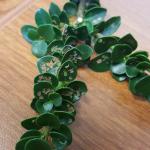
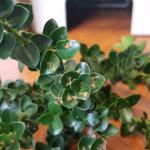 Redheaded Flea Beetle (Systena frontalis) has been identified as a native pest of nurseries in many locations in the eastern United States. Suspected redheaded flea beetle damage was seen on Ilex crenata 'Dwarf Pagoda' (Dwarf Pagoda Japanese holly) on 3/27/2024 that was purchased in Massachusetts but may have originated in NJ. While identification of this species of insect is uncertain based on host plant damage alone, it appears to be a reasonable and educated assumption. Redheaded flea beetles are known to feed on a wide variety of host plants. These include but are not limited to: cabbage, beans, beets, blueberries, and other agricultural crops as well as Physocarpus, Weigelia, Cornus, Forsythia, Itea, Hydrangea, and Ilex. Adult beetles are active and feed from approximately late-June to mid-September on the upper and lower leaf surfaces of their hosts. This can cause damage that looks like skeletonization and eventually holes in the leaves. Leaves appear covered in brown patches as in these photos. This damage was caused last season on this evergreen plant.
Redheaded Flea Beetle (Systena frontalis) has been identified as a native pest of nurseries in many locations in the eastern United States. Suspected redheaded flea beetle damage was seen on Ilex crenata 'Dwarf Pagoda' (Dwarf Pagoda Japanese holly) on 3/27/2024 that was purchased in Massachusetts but may have originated in NJ. While identification of this species of insect is uncertain based on host plant damage alone, it appears to be a reasonable and educated assumption. Redheaded flea beetles are known to feed on a wide variety of host plants. These include but are not limited to: cabbage, beans, beets, blueberries, and other agricultural crops as well as Physocarpus, Weigelia, Cornus, Forsythia, Itea, Hydrangea, and Ilex. Adult beetles are active and feed from approximately late-June to mid-September on the upper and lower leaf surfaces of their hosts. This can cause damage that looks like skeletonization and eventually holes in the leaves. Leaves appear covered in brown patches as in these photos. This damage was caused last season on this evergreen plant.- Snowball Aphid overwinters as an egg on the twigs and buds of Viburnum spp. hosts. Egg hatch occurs at the same time host plant buds are opening in the spring. Newly hatched aphids will begin to feed on and distort the newly developing leaves of their hosts. Aphids may be protected from contact insecticides within curled leaves.
- Southern Pine Beetle has been trapped in Massachusetts since 2015. By 2022 & 2023, southern pine beetle has reached outbreak conditions in small areas of the state, killing pitch pine (Pinus rigida). (Particularly on Martha’s Vineyard and Nantucket islands in MA.) If you believe you have found infested pitch pine in Massachusetts, please report southern pine beetle here.
- Spruce Bud Scale overwinters as an immature scale on the undersides of host plant needles. Once spring temperatures warm, the dormant scales become active by late March and in April female spruce bud scales move to host plant twigs. Adult females are reddish-brown and round, and usually found at the base of new twig growth.
- Spruce Spider Mite is a cool season mite which causes most of its feeding damage on coniferous hosts in the spring and fall. Monitor for discolored needles and the mites themselves. Monitoring for spruce spider mite can be done by shaking 3-4 branches over a white piece of paper and viewing mites with a hand lens.
- Tuliptree Scale is a soft scale pest of Liriodendron and Magnolia spp. among others. Second instar nymphs overwinter, begin feeding as temperatures warm in the spring, and mature into adults by the late spring/early summer.
- Viburnum Leaf Beetle overwinters on susceptible viburnum as eggs laid in pits chewed near the ends of twigs last season. These egg laying locations are covered with an oval-round cap. Prune out and destroy infested twigs prior to egg hatch in May.
- White Pine Aphid eggs overwinter in rows on the needles of their host plants. Egg hatch will occur as spring temperatures begin to warm. Aphids may feed on the needles, twigs, and small branches of their host plants.
- White Pine Weevil overwinters as an adult in the leaf litter in sheltered areas near host plants. As spring temperatures warm, adults fly to the leaders of Pinus and Picea spp. hosts where they mate, dig round holes in the bark, and deposit 1-5 tiny eggs in the cavity. Eggs hatch and the larvae tunnel as they feed, killing the previous season’s leader. Adult white pine weevils are active in March (through May), as soon as 7 GDD’s are reached.
- Woolly Apple Aphid overwinters as eggs in the cracks and crevices of Ulmus spp. host plants. As spring temperatures warm, these eggs hatch and stem mothers begin feeding on developing elm leaves. Their feeding and the feeding of the wingless nymphs they produce causes leaf distortion and a rosette to form on elm. If no elm is present, the aphids will complete their life cycle on apple year-round.
- Woolly Beech Leaf Aphid overwinters as eggs in host plant bark crevices near buds. At budbreak, eggs hatch and wool covered aphids begin feeding on host plant leaf undersides (Fagus spp.). Even though aphid populations may be very noticeable, they seldom require chemical management.
- Woolly Elm Aphid overwinters as eggs hidden in cracks and crevices of elm bark. As leaves unfold in the spring, eggs hatch and young aphids feed on the underside of elm leaf tissue. These aphids mature and give birth to hundreds of additional females. Feeding causes leaves to curl around the aphids. Curled leaves may also turn reddish brown.
Beneficials/Non-Pests:
 Winter Firefly is one common name for Ellychnia corrusca, a type of beetle in the Family Lampyridae. Another is “sap bucket beetle”. This species overwinters in the adult life stage and these beetles may live for up to two years! Interestingly, the winter firefly is unable to bioluminesce or glow for most of the adult life stage. Eggs, larvae, and pupae of this species are known to glow. Adults do so very early in their adulthood, for perhaps a few hours, and then cease to have the ability. Adults may become active on warm days as early as late February, doing most of their mating in April and May. They may be seen crawling around sheltered areas, in downed debris, or gardens. Adult beetles are thought to be predaceous insects and are not garden pests. For more information, visit this page from the University of Maine Cooperative Extension.
Winter Firefly is one common name for Ellychnia corrusca, a type of beetle in the Family Lampyridae. Another is “sap bucket beetle”. This species overwinters in the adult life stage and these beetles may live for up to two years! Interestingly, the winter firefly is unable to bioluminesce or glow for most of the adult life stage. Eggs, larvae, and pupae of this species are known to glow. Adults do so very early in their adulthood, for perhaps a few hours, and then cease to have the ability. Adults may become active on warm days as early as late February, doing most of their mating in April and May. They may be seen crawling around sheltered areas, in downed debris, or gardens. Adult beetles are thought to be predaceous insects and are not garden pests. For more information, visit this page from the University of Maine Cooperative Extension.
Reported by Tawny Simisky, Extension Entomologist, UMass Extension Landscape, Nursery, & Urban Forestry Program
Landscape Weeds
Tree seedlings are continuing to germinate in landscape beds and some locations may have seedlings that are 2 to 3 inches tall. These seedlings can be treated with pelargonic acid (ScytheTM). Another option would be to cut these seedlings down with powered hedge shears at the soil or mulch surface. The organic/non-chemical products do not translocate and will not provide effective control of these young tree seedlings. Tree seedlings in turf areas will be controlled with mowing and an herbicide application is not necessary.
Landscape mulch should be the first defense against weeds in landscape beds. Mulching can be done now at the beginning of the season before summer annual weeds germinate. Small winter annual weeds can be smothered with mulch. Freshly mulched landscape beds will not immediately require a preemergence herbicide application because the fresh mulch should supply adequate summer annual weed control in the short term. Preemergence herbicide application should be considered now for mulched areas that have not been freshly mulched, or later in the season for those areas that were freshly mulched this spring. Preemergence herbicides should be applied on top of landscape mulches, not underneath them. Compost is not recommended as a mulching material.
Many winter annual weeds are coming out of winter dormancy and are beginning to flower in turf and landscape areas. An attempt to control these weeds early will decrease the number of seeds they produce. Winter annuals will complete their life cycle as the weather warms. A fresh layer of landscape mulch will control them by smothering. If populations are dense in turf, a broadleaf herbicide combination can be considered. Common winter annual weeds being observed now are:
- mouse-ear cress (Arabidopsis thaliana)
- thymeleaf sandwort (Arenaria serpyllifolia)
- downy brome (Bromus tectorum)
- shepherd's-purse (Capsella bursa-pastoris)
- bittercress (Cardamine hirsuta)
- sticky chickweed (Cerastium viscosum)
- horseweed (Conyza canadensis)
- spring whitlowgrass (Draba verna)
- henbit (Lamium amplexicaule)
- red deadnettle (Lamium purpureum)
- field pepperweed (Lepidium campestre)
- Virginia pepperweed (Lepidium virginicum)
- pineappleweed (Matricaria matricariodes)
- annual bluegrass (Poa annua)
- knawel (Scleranthus annuus)
- common chickweed (Stellaria media)
- field pennycress (Thlaspi arvense)
- corn speedwell (Veronica arvensis)
- purslane speedwell (Veronica peregrina)
For information about identification of these weeds, check out UMass Extension's Weed Herbarium.
Lesser celandine, also called fig buttercup, fig-crowfoot, or dusky maiden, (Ficaria verna or Ranunculus ficaria), is an herbaceous invasive perennial plant found throughout New England. This species is a spring ephemeral, with shiny, dark green, kidney-shaped leaves and bright-yellow, glossy, flowers with 8 to 12 petals. As a spring ephemeral, it is only apparent in the spring and dormant the rest of the year. Lesser celandine reproduces by bulblets, tuberous roots, and seeds. As a spring ephemeral, it's often difficult to determine if an herbicide worked or the symptoms you see is just the species becoming dormant later in the spring or early summer. Herbicides known to effectively control lesser celandine in turf are triclopyr and dicamba. Products that contain both herbicides are the best choice. Populations of lesser celandine in landscape beds can be controlled with directed-spray applications of glyphosate. For early occurrences of this weed in new locations, consider digging plants up and disposing of them in a manner that will prevent their further spread.
Preemergence herbicide application for annual grass control should be on the front burner as forsythia, Forsythia intermedia, is the phenological indicator for these applications. Applications of these herbicides should be timed for when forsythia is in full bloom with the last application occurring as the first few flowers hit the ground (typically late April to very, very early May).
Many landscape trees commonly produce vegetative suckers at the base of trees. Suckers are commonly seen on crabapple, flowering cherry, flowering pear, plum, linden, maple and sometimes oak. Honeylocust commonly produces vegetative sprouts along the entire length of their trunk. If these suckers or sprouts are not controlled, the landscape will be a contender for the “Shabby Landscape Award”. Pruning is effective but very time consuming. Another option is to use the product ScytheTM that contains pelargonic acid to remove these vegetative suckers and sprouts when they are very small. Very small means less than one inch in length or smaller. Pelargonic acid is a contact herbicide. If ScytheTM is applied to small suckers and sprouts, the product will desiccate them and physical removal will not be required. Larger growth will first need to be physically removed and then ScytheTM can be used as a maintenance program. Products that contain glyphosate should not be used as glyphosate is a translocated herbicide and injury to the tree is possible.
Reported by Randy Prostak, Weed Specialist, UMass Extension Landscape, Nursery, and Urban Forestry Program
Additional Resources
Pesticide License Exams - The MA Dept. of Agricultural Resources (MDAR) is now holding exams online. For more information and how to register, go to: https://www.mass.gov/pesticide-examination-and-licensing.
To receive immediate notification when the next Landscape Message update is posted, join our e-mail list or follow us on Facebook.
For a complete listing of landscape, nursery, and urban forestry program upcoming events, see our calendar at https://ag.umass.edu/landscape/upcoming-events.
For commercial growers of greenhouse crops and flowers - Check out UMass Extension's Greenhouse Update website.
For professional turf managers - Check out our Turf Management Updates.
For home gardeners and garden retailers - Check out our home lawn and garden resources.
Diagnostic Services
UMass Laboratory Diagnoses Landscape and Turf Problems - The UMass Extension Plant Diagnostic Lab is available to serve commercial landscape contractors, turf managers, arborists, nurseries and other green industry professionals. It provides woody plant and turf disease analysis, woody plant and turf insect identification, turfgrass identification, weed identification, and offers a report of pest management strategies that are research based, economically sound and environmentally appropriate for the situation. Accurate diagnosis for a turf or landscape problem can often eliminate or reduce the need for pesticide use. For sampling procedures, detailed submission instructions and a list of fees, see the Plant Diagnostic Laboratory web site.
Soil and Plant Nutrient Testing - The University of Massachusetts Soil and Plant Nutrient Testing Laboratory is located on the campus of the University of Massachusetts at Amherst. Testing services are available to all. The lab provides test results and recommendations that lead to the wise and economical use of soils and soil amendments. For more information, including current turn-around times, visit the UMass Soil and Plant Nutrient Testing Laboratory web site. The lab is currently accepting orders for Routine Soil Analysis (including optional Organic Matter, Soluble Salts, and Nitrate testing), Particle Size Analysis, Pre-Sidedress Nitrate (PSNT), Total Sorbed Metals, and Soilless Media (no other types of soil analyses available at this time). Check for current turnaround time. Please plan for the fact that date of receipt in the lab is affected by weekends, holidays, shipping time, and time for UMass Campus Mail to deliver samples to the lab.
Tick Testing - The UMass Center for Agriculture, Food, and the Environment provides a list of potential tick identification and testing options at https://ag.umass.edu/resources/tick-testing-resources.
Acknowledgements: UMass Extension gratefully acknowledges the support of the following funding sources for the production of the Landscape Message –
- The Massachusetts Nursery and Landscape Association Fund
- The Massachusetts Department of Conservation and Recreation, Award #ISADCR28219926UMA24A
- Stakeholders like you! The Landscape Message is partially supported by educational program user fees.
